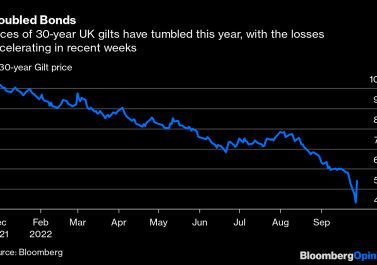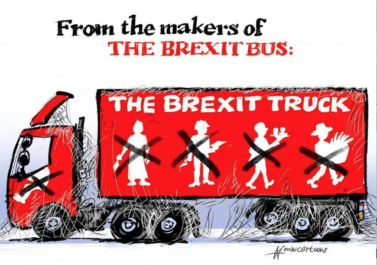
In the coming couple of weeks, we will publish an article reflecting on the ‘Don’t Pay’ campaign against high energy prices, a general assessment of the current UK ‘strike wave’, an interview with a militant worker at Royal Mail and some thoughts after the first two days of health workers’ strikes in the NHS. The following text is based on a discussion we had at a recent AngryWorkers gathering in London about the wider economic and political background of the current moment. It can be read in conjunction with this previously published article on the situation in the UK.
1. Inflation and recession
The UK has the highest rate of inflation and levels of recession compared to the EU and the US, partly due to Brexit and the decline of the pound, partly due to inability to restructure its productive base.
The watchword of the current moment in the UK is “crisis”. The speculated recovery from the general stoop of the Covid crisis has dramatically failed to materialise, and in its place we have been landed in a compounding vat of shit. Currently, the UK economy has entered a recession that is forecast to last for more than a year, with GDP set to contract by 1.4% in 2023. For reference, that’s relatively shallow compared to the sharp shocks of 2008 (-4.2%) and 2020 (-9.3%). The main difficulty is the problem of inflation, which currently sits at a 40 year high with an annual rate of 11.1%(CPIH) as of October 2022 statistics. By RPI, this puts the UK in an inflationary situation worse than the 1990 economic crisis by around 5%. Combining these, despite the relatively ‘mild’ recession, we are actually now facing the worst fall in living standards in at least 60 years, and it goes without saying that the working class stands to feel the sharpest edge of the crisis sword. In short, we’re in for a long and miserable few years.
Inflation is not forecast to slow until Q3 2023, and alongside this the economic contraction is expected to precipitate a significant rise in the rate of unemployment next year to 4.9%, from the current 3.6% – meaning 500,000 job losses. At the best of times, bourgeois employment data is limited due to its low bar of requirements for what constitutes employment, infamously considering workers on zero-hours contracts or operating within the so-called gig economy as “employed”. A drop in employment such as that forecast would be a considerable hit on the working class, in contrast to the still prevailing situation of ‘shortage of labour power’ in many sectors. Vacancies have fallen by around 50,000 between August and November, and despite the amount of payrolled employees increasing by over 800,000 since February 2020, the number of hours worked has actually decreased by 13.3 million since the same time.
The number of over-50 year olds who are on zero-hour contracts has reached a new peak in December 2022. Amidst the backdrop of high rate, high inflation and huge amounts of uncertainty then, workers in the UK are under a new attack that will try to use a constricting labour market to enforce further deterioration of terms and conditions. The aim of this attack was summarised by a member of the UK Monetary Policy Committee after the latest interest rate increase of the Bank of England in December 2022, who said that the central bank needed to combat “an inflation psychology that was embedding in wage settlements and inflation expectations”.
2. The ‘mini budget’ disaster
The last year has been a long episode of inconsistent political leadership from the ruling class. The ruling Conservative Party has been following an all too predictable trajectory, from one right-wing ghoul to another, floundering more and more at each iteration. The cliff edge of crisis was steepened in the short reign of Liz Truss with the release of Kwasi Kwarteng’s “mini-budget”. Liz and Kwasi, being the political beneficiaries of the “free-market think-tank” Institute of Economic Affairs’ sponsorship, attempted to introduce a radical sweep of fiscal reforms. Tax breaks for the highest paid, corporations etc, clampdowns on benefit claimants etc. The outcome was the impressive near obliteration of most pension funds and a stern dressing down by the paragons of progressivism at the International Monetary Fund.
Despite it being a particularly pertinent example of the representatives of capital shooting themselves in the foot in spectacular fashion, the question of what drove the so-called “mini budget” is still worth dwelling on. What was its strategy? It would be easy to suggest that it was just the naked expression of ideological floundering. What else can you do when you’re a weakening capitalist power facing a global crisis but hit the “animate Thatcher’s corpse” button as hard as you can?
The mini-budget was not just an expression of a deranged or headless political faction, but an attempt to force the UK into a deregulated position in the global market, with strong US ties. This effort has been rebuffed not only by the IMF and markets, but also by the fact that despite Johnsons ‘pro-US / pro-Ukraine’ efforts, the US has not shown much interest in a trade deal. The US wants to further soften the resistance towards investments and trade liberalisation in US interest (see conflicts around Huawei, microchips and 5G investments from China; conflict around the access to the NHS and UK food market etc.)
The UK remains in a particularly unstable position geopolitically, having been repeatedly brushed off by the US in denied trade agreements since Brexit. It is then reasonable to assume that the effort of the “mini budget” was behind creating a low tax, high investment, deregulated, enterprise zone country-wide in an attempt to attract US capital investment. It was their self-professed aim to put forward a “growth package”, and by the most vulgar neo-classical economic reckoning the way to do that would be to cut the tax burden, invite speculation and de-value labour – all elements encapsulated in the disaster that was the mini-budget. The reaction of the IMF proves interesting from a number of angles. Firstly, it seems that the global bourgeoisie is closing ranks, and will suffer little deviation from their set path of fiscal tightening, and “targeted fiscal support” for the most vulnerable in the “war on inflation”.
It is clear that the arbiters of class power are all too aware of the need for iron discipline in the face of a global economic crisis of capital. Perhaps it is also worried by the explosive reactions of proletarians in the peripheries such as Sri Lanka, Kazakhstan and elsewhere to their pernicious policy programmes where looming sovereign debt crises compound the already messy global economy. Secondly, this intervention stands quite clearly in the way of the goals of the Labour left types, who imagine that with a capture of a social democratic apparatus in the UK, they could enact some sort of New Deal reform programme to usher in a moderate sort of socialism. Even in the relatively stronger economies, with their ability to essentially inflate their own spending, such as the UK, international capital is clearly able to exert power as has been demonstrated in the ‘market’s’ withdrawal from gilts in the UK. Without the intervention of the Bank of England in the form of the purchase of billions of pounds in bonds, the majority of workers’ pensions would have been simply wiped from the face of the earth in a matter of hours, so volatile is the credit base of fictitious capital. The IMF was seriously worried that a UK pension fund melt-down would directly ripple into the wider global financial system.
3. The current government
In response then, the wind shifted in favour of another clique of the Conservative Party, this time without the input of the 100,000 strong hospice that is the Conservative Party’s membership, and last time’s runner up Rishi Sunak took the reins of state. Orienting against the disaster of the “mini budget”, the new government set about aiming to restore a level of confidence from the market, reversing most of the policies of the previous administration. The most pertinent political/economic direction of the current government was expressed by the “budget” in October. (ref: For international comrades, the “budget” is the annual announcement of the government’s plan for fiscal policy.) A £55 billion fiscal consolidation was announced, planning to fund just over half through spending cuts and the rest through increases in taxation. In opposition to the apparent aims of the “mini-budget”, fiscal support for education, healthcare and energy costs have been increased and extended, with benefits and pensions pledged to rise more or less by the rate of inflation. In an attempt to mitigate market fragility, the government has re-written its fiscal rules to mean that the target for debt reduction has been relaxed and debt must now be declining as a proportion of GDP by the fifth year of the OBR’s forecast rather than the third. This move seems widely to have been accepted, granting the government more leeway with which to navigate the recession.
Funding increases for public services will likely be offset by (even meagre) wage rises and the increasing cost of energy. The government’s Energy Price Guarantee scheme means that average household energy costs are expected to increase from £2,500 to £3,000 and be capped there until April 2024 (around 268% higher than the same time in 2021). Business energy support will end in April 2023, except in the “most vulnerable cases”. This has caused a rumbling of discontent and opposition among business groups, as it is expected that if high energy costs persist, it will wipe out a majority of small, marginally profitable/unprofitable firms where energy makes up a high proportion of operational outlays. On top of this, the budget has been widely criticised by some sections of capital, particularly domestic productive capital, by the lack of focus on growth and productivity while increasing taxes on profit and business. The Labour Party also joined this line of attack, abandoning its traditional line of proposing increases in taxation to fund public services and infrastructure investment in favour of an approach more focused on increasing productivity.
The budget left £10 billion of fiscal ‘headroom’ – funds projected to be raised in excess of what is ‘required’ in order to provide a basis for manoeuvrability. Strikingly, this is less than is usually allocated to this purpose in budgets – in comparison, a pay increase for all public sector workers in line with inflation would cost an estimated £13 billion. The reduced ‘excess’ funds allocated suggests continued structural pressures that the state has to confront, as the recession and global crisis of capital shows few signs of abating. While the October budget showed an attempt to separate this government from its predecessor, the economic strategy shows signals of a more cautious trajectory towards the same ends.
Jeremy Hunt, the current chancellor, announced sweeping reforms to regulations on financial services. This move looks to loosen many of the legislative constraints imposed on the sector after the 2008-2009 “Great Recession”, freeing financial service operators from many of the restrictions such as prevention of banks issuing loans backed by riskier and more convoluted webs of credit. It also removed laws that would hold firms’ bosses personally and financially responsible for disasters that occur under their watch. This suggests that the government is still attempting to orient itself toward an economy based on servicing debt for stronger fragments of capital, particularly attempting to draw capital from investment in the US. Perhaps this is also a move to strengthen the UK currency, as attracting more investment through UK financial services would require more transactions conducted in Sterling. It also represents a political intervention into market operations, ordering the Financial Conduct Authority to prioritise ‘competitiveness’ over its previous emphasis on stability.
4. The current attack on the working class
The current Tory position is a fudge, expressed in their aim for a Swiss-style relation with the EU after the US-axis fell apart, to calm the markets, and leave doors open and win time. With little influence over the international market and lack of profitable capital investments, the only show of strength they can muster at the moment is towards ‘their own working class’, which creates political tensions around the strikes and gives them a wider structural context.
The latest threat of political attack is the increasing pressure on the government to legislate in order to curb the ability of unions to strike. Earlier in the year, the government introduced new laws that allowed employers to use agency workers to break strikes, and make it easier to claim up to one million pounds in damages from unions in cases of any illegal strikes. Another attack has come in the form of the government proposing to introduce minimum service constraints on workers that are considered “essential”. This is being held at bay however due to ministers’ fears that moving to introduce such measures would exacerbate the disputes currently in effect, and spark more unrest with over 400,000 days being expected to be lost to strike action in December.
There is a delicate balance in this, with certain factions within the Tory party pushing harder for anti-strike laws, whilst ministers are more cautious. It seems clear that such laws will become more of a threat if the working class takes a backward step. Only by moving toward the offensive can the defensive elements of the struggle be maintained. This effort by the government to ‘look tough’ in a situation of weakness’ is also reflected in a) encouraging more migration from non-EU countries due to labour shortage on one side (visible, for example, in the fact that now workers from Nepal and Indonesia are recruited for agricultural work!) and b) pretending to be tough when it comes to the ‘Rwanda deportation spectacle’ on the other.
In this situation the traditional left is left without direction, as a) the official line of the Labour Party after the Tory u-turns is mirroring most of the government line, e.g. when it comes to hostile reaction towards strikes or the need for ‘taxation’; and b) because of the realisation that an actual ‘reformist’ or more seriously ‘distributive’ government a la Corbyn would have met the same fate under IMF and global market responses like the mini-budget government. We therefore see a large trend towards cheerleading ‘bread and butter’ syndicalism, which fails on two fronts: it is not able to discuss the wider political and global context of the strikes and, following largely the official line of the trade unions, it doesn’t help to understand the strong and weak points of the strikes and the potentials for generalisation. This issue will be addressed in the upcoming article on the current strike wave.
The current configuration of the class struggle from the perspective of the working class is defined primarily by the two elements of high inflation and a relatively tight labour market. It is these conditions that have shaped the wave of strikes in the UK. Whilst it is clear that the UK is not alone in facing this sharpening crisis, the UK’s position toward the bottom of the ladder of bourgeois nations in terms of growth and inflation have created the conditions to nudge a sleeping labour movement into the conscious side of dormancy.
The general consciousness of workers in the UK seems to have been conditioned by the categorisation of “essential work”, a lingering lesson of the pandemic. In the face of rising prices, workers have demonstrated an increased willingness to engage in strikes in order to defend the value of their labour-power. With a deepening global crisis of capital on the horizon, it is imperative that we attempt to decide and determine our own struggles and begin to develop a political vision of working class autonomy. We must learn from our struggles and encourage proletarian revolt wherever we can find it.



